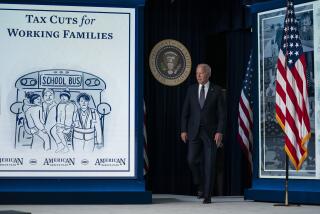Kids’ Allowances Can Still Be Teaching Tool : Fiscal Responsibility on $11.75 a Week
- Share via
WASHINGTON — In these competitive times, one group of workers is getting paid more to work less: our children.
New findings from a survey released by Massachusetts Mutual Life Insurance Co. show that most 8- to 12-year-olds do two chores a day, far less than their parents did.
And these chores, notes researcher Rebecca Shahmoon Shanok, are of the “hit and run” variety.
“Kids bop in and do something in a hurry (like empty the trash or vacuum the living room) and then they run out,” Shanok said.
But wait--other findings show that these same speedy workers are earning more for their work.
James McNeal, a marketing professor and kid-money expert at Texas A&M; University, notes that in the past six or seven years, the amount of money children get for household chores has grown--both in dollar terms and as a percentage of their total take.
Six years ago, McNeal says, kids received 53% of their money as no-strings-attached allowances and 15% as payment for services rendered.
Now those percentages are 45% and 21%, respectively. Grandparents and outside work make up most of the difference.
Today’s hit-and-run, trash-emptying 12-year-old might bring in a total of $11.75 a week from all sources, estimates McNeal, with about $2.50 of that payment for chores.
Is this a good idea? The historical answer is no. For years we’ve been steeped in the idea that putting a price tag on household tasks harms the spirit of family cooperation. Now some experts differ.
“Generally, it should be tied,” McNeal said. “Parents want to teach their children the connection of responsibility and work and rewards. Generally, that’s the correct way to do it.”
There’s another type of string being tied to allowances today. Kids have a much greater role in spending family money, McNeal says. They pick out about 80% of their clothes, a reversal of the 80% impact Mom had a generation ago. They get sent to the store to pick up their own school supplies and rent their own video games.
Often, their allowances are enlarged to cover these added items. Buy too many candy bars and you can end up without fashionable footwear or even a notebook on your first day of school.
There’s a spate of new kid-and-money books on the market that offer different takes on these questions. Here are some of their authors’ best suggestions for balancing familial responsibility with allowances that allow for fun.
Janet Bodnar, author of “Kiplinger’s Money Smart Kids,” offers the following wisdom: Dole out an allowance in a variety of small-denomination coins and bills to help teach the value of money.
As children get older, give them more responsibility for covering the costs of their lifestyles. A 10-year-old can buy snacks and comic books; a 15-year-old can kick in for clothes, movie tickets and youth group trips.
Bodnar also suggests the negative-option method of linking money to chores. Put your kid’s allowance, all in dimes or quarters, in a glass jar. When they fail to keep up their regular responsibilities or respond to your request for help, remove a coin.
Patricia Schiff Estess and Irving Barocas, authors of “Kids, Money & Values,” advise parents never to link chores and allowances because it lets children think they can buy their way out of work. Instead, reward jobs well done with extra treats, they suggest.
When teen-agers are old enough to buy their own clothes, dole the money out monthly or by season to help them make it last.
“Money Doesn’t Grow on Trees” by Neale Godfrey advises parents to develop allowances using a formula that includes savings, spending and charitable donations. A proper balance might be 60% spending, 30% savings and 10% charity.
Figure out realistic expenses for your child, add in savings and charity and pay an allowance that lets them handle all three.
Godfrey doesn’t specifically tie financial amounts to chores, but her children’s chores must be completed before they get their allowances.
She also tells parents to tax allowances. These tariffs can go into a family kitty that pays for something the entire family can enjoy and use.
Finally, my own allowance tips: Give the kids enough money to buy lunch two or three days a week, but lay in a stock of good lunch food.
If they pack their lunches, they pocket the money.
Even when lazy, they can’t afford to “eat out” every day. And give kids ages 10 and up the opportunity to get their money monthly instead of weekly. This helps them learn to budget, divide their money into bigger chunks and learn at a tender age about that too-much-month-at-the-end-of-the-money syndrome.
More to Read
Inside the business of entertainment
The Wide Shot brings you news, analysis and insights on everything from streaming wars to production — and what it all means for the future.
You may occasionally receive promotional content from the Los Angeles Times.










